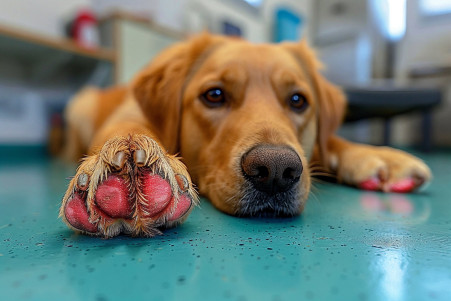How to Wrap a Dog's Paw the Right Way: A Step-by-Step Guide
21 April 2024 • Updated 21 April 2024

Wrapping a dog's paw correctly is essential for preventing further injury and aiding in the healing process, but how exactly should you do it? To wrap a dog's paw, you'll want to start by gently cleaning and disinfecting the wound, then placing a non-stick pad, and finally using a self-adherent cohesive bandage to wrap the paw from the toes up in a figure-8 pattern. Be careful not to wrap the bandage too tight, as this can cut off circulation. Make sure to change the bandage daily to check on the healing process.
In this article, we'll break down the most successful methods and precautions recommended by veterinarians to help you understand the process in a step-by-step manner. By exploring advice that's backed by science, you'll be able to confidently and safely wrap your dog's paw when they experience minor injuries. Our guide will help you make sure that your pup gets the care they need to heal as quickly as possible.
How do you properly wrap a dog's paw?
Getting Ready to Wrap: What You Need and How to Clean the Wound
Before you wrap your dog's paw, it's important to make sure you have the right supplies and that you've cleaned the wound thoroughly. According to MetLife Pet Insurance, you'll need antiseptic, sterile gauze pads, adhesive tape, non-stick bandages, scissors, and tweezers. Keeping these items in a pet first aid kit will ensure that you're ready to handle minor paw injuries.
Cleaning the wound is the first and most important step. You should carefully examine the area and use tweezers to remove any foreign objects, such as dirt, glass, or metal. After that, you should clean the wound with a mild antibacterial soap and then pat it dry, says MetLife. You may also need to trim the fur around the wound to make sure that it's easier to access.
If the wound is bleeding, you should apply pressure with a clean cloth until the bleeding stops, according to VCA Animal Hospitals. That said, if the bleeding doesn't stop after 10-15 minutes, you should take your dog to the vet immediately, as this could be a sign of a more serious injury.
Once the wound is clean and dry, you can apply an antibiotic ointment if your vet has recommended it. With the right supplies on hand and the wound properly cleaned, you're ready to start wrapping the paw to help it heal.
How to Wrap a Dog's Paw: A Veterinarian Shares How
Per How to Wrap a Dog's Paw: A Veterinarian Shares How, the basic steps for wrapping a dog's paw for minor wounds or sprains are as follows:
Use a sterile gauze pad as the primary contact layer directly on the wound. You can add a light layer of antibiotic ointment to the gauze to help prevent infection.
Wrap the paw in rolled gauze, starting at the toes and working up the leg. Overlap each wrap by about 50% to ensure a secure wrap.
Use a self-adherent bandage material like VetWrap or Coban to create an outer layer. Wrap the bandage in a figure-8 pattern around the paw and ankle/wrist area to keep the wrap in place.
The Berkeley Vet Blog notes that the wrap should be snug but not too tight so that blood flow is not restricted. You should be able to fit 1-2 fingers between the wrap and your dog's leg.
To prevent your dog from chewing or licking the wrap, the VCA Animal Hospitals suggest using an Elizabethan collar or a bitter anti-lick spray. It's also important to check the wrap regularly and change it if it gets wet or dirty.
By layering the materials correctly and ensuring that the wrap is secure and comfortable, you can successfully wrap your dog's paw to help with the healing process for minor wounds and sprains. However, if the wound is more serious or you suspect a fracture, it's important to get your dog to the vet as soon as possible.
Splinting and Bandaging Paw Fractures and Broken Toes
If you suspect that your dog has a paw fracture or a broken toe, it's important to get them to the vet. According to Veterinary Surgery Online, it's important to make sure that the affected area is properly immobilized and treated. Splints or casts are often used in combination with bandages to help stabilize the area.
To apply a splint or cast, first wrap the limb in a thin layer of cotton or foam, especially around bony prominences. Next, apply strips of plaster-of-Paris or fiberglass casting material, molding the material to the shape of the leg. As explained by Cuteness, the splint should extend beyond the fracture line and cover at least one joint above and below the fracture.
After the splint is in place, wrap it with gauze to secure it, making sure that it's tight and even but not so tight that it cuts off circulation. WSAVA recommends cutting the edges of the cast so that at least one-third of the limb is exposed.
To make sure that your dog doesn't chew or lick at the bandage, you can use an Elizabethan collar, and you should also make sure to keep your dog's activity level low while the fracture heals, according to Cuteness. With the right care and immobilization, your dog's paw fracture or broken toe should heal in no time.
Bandaging and Wound Care After Surgery
Bandaging and wound care are important parts of the recovery process after surgery on a dog's paw or leg. As noted by the Veterinary Orthopaedic and Mobility Center, bandages, splints, and casts are often used to help support healing and protect surgical repairs. The length of time a bandage will be needed can range from 1-2 weeks to 8-10 weeks, depending on the nature of the injury.
Today's Veterinary Practice notes that bandages used after surgery typically consist of a primary contact layer of sterile gauze, a secondary absorbent layer, and a tertiary outer layer for protection and compression. The specific materials used will depend on the type of wound and the phase of healing.
It is important to ensure that the paw is clean and dry before applying a post-surgical bandage and to follow a specific technique, such as the one outlined in Wound Bandaging Techniques for Small Animals. This will ensure that the bandage is applied correctly, including the proper layering of materials and the secure application of the bandage without cutting off circulation.
Throughout the healing process, it is important to keep the bandage clean and dry and to watch for signs of infection or other issues. VOMC advises using a protective booty when walking the dog and an Elizabethan collar to prevent chewing or licking. Regularly checking the bandage and seeking veterinary care if problems arise will help ensure that the dog heals successfully.
Check and Change Bandages to Ensure Proper Healing
Checking and changing your dog's bandage regularly is important to help ensure that the wound heals properly and to prevent any issues. VCA Animal Hospitals suggests checking the bandage every day and changing it if it gets wet, soiled, or damaged. The frequency of bandage changes can depend on the type of injury or surgery.
For example, MedVet notes that bandages used to cover a surgical incision or a closed wound may only need to be changed every 1-2 weeks. On the other hand, bandages covering an open wound or an area that's infected may need to be changed more frequently, perhaps every few days, so that the wound can be checked for signs of healing or infection.
When you take the bandage off and put a new one on, make sure to check the wound for redness, swelling, discharge, or a bad smell, which could indicate that you need to take your dog to the vet. VOMC suggests cleaning the area with a mild antiseptic solution before applying a fresh, sterile dressing.
If you notice anything that worries you, make sure to call your vet. Proper monitoring and changing of the bandage are important to make sure that your dog's paw heals well and doesn't experience any complications.
Conclusion: How to Make Sure Your Dog's Paws Heal Quickly
Properly wrapping and caring for your dog's paw is essential for promoting healing and preventing further injury or infection. By learning the techniques provided in this article, you can feel confident in your ability to address minor paw injuries, sprains, fractures, and post-surgical needs.
That said, it's important to remember that veterinary care is necessary for severe wounds, suspected fractures, or if any complications arise. Proper bandaging, regular monitoring, and preventing your dog from disturbing the wrap are all key to ensuring a smooth recovery.
By making sure you have the right materials and know how to properly apply bandages, you can help your dog get back on their feet in no time. Feel free to use this article as a reference when providing your dog with the best paw care possible.


